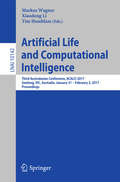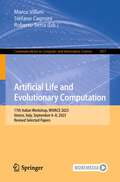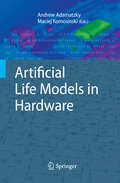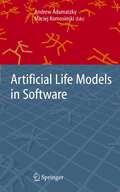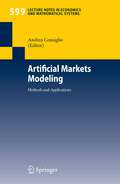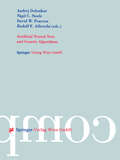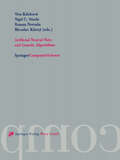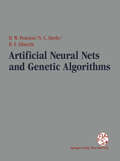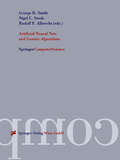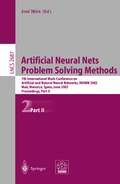- Table View
- List View
Artificial Intelligent Techniques for Wireless Communication and Networking
by R. Kanthavel K. Ananthajothi S. Balamurugan R. Karthik GaneshARTIFICIAL INTELLIGENT TECHNIQUES FOR WIRELESS COMMUNICATION AND NETWORKING The 20 chapters address AI principles and techniques used in wireless communication and networking and outline their benefit, function, and future role in the field. Wireless communication and networking based on AI concepts and techniques are explored in this book, specifically focusing on the current research in the field by highlighting empirical results along with theoretical concepts. The possibility of applying AI mechanisms towards security aspects in the communication domain is elaborated; also explored is the application side of integrated technologies that enhance AI-based innovations, insights, intelligent predictions, cost optimization, inventory management, identification processes, classification mechanisms, cooperative spectrum sensing techniques, ad-hoc network architecture, and protocol and simulation-based environments. Audience Researchers, industry IT engineers, and graduate students working on and implementing AI-based wireless sensor networks, 5G, IoT, deep learning, reinforcement learning, and robotics in WSN, and related technologies.
Artificial Intelligent Techniques for Wireless Communication and Networking
by R. Kanthavel K. Anathajothi S. Balamurugan R. Karthik GaneshARTIFICIAL INTELLIGENT TECHNIQUES FOR WIRELESS COMMUNICATION AND NETWORKING The 20 chapters address AI principles and techniques used in wireless communication and networking and outline their benefit, function, and future role in the field. Wireless communication and networking based on AI concepts and techniques are explored in this book, specifically focusing on the current research in the field by highlighting empirical results along with theoretical concepts. The possibility of applying AI mechanisms towards security aspects in the communication domain is elaborated; also explored is the application side of integrated technologies that enhance AI-based innovations, insights, intelligent predictions, cost optimization, inventory management, identification processes, classification mechanisms, cooperative spectrum sensing techniques, ad-hoc network architecture, and protocol and simulation-based environments. Audience Researchers, industry IT engineers, and graduate students working on and implementing AI-based wireless sensor networks, 5G, IoT, deep learning, reinforcement learning, and robotics in WSN, and related technologies.
Artificial Life: 4th Australian Conference, ACAL 2009, Melbourne, Australia, December 1-4, 2009, Proceedings (Lecture Notes in Computer Science #5865)
by Kevin B. Korb Marcus Randall Tim HendtlassThis book constitutes the refereed proceedings of the 4th Australian Conference on Artificial Life, ACAL 2009, held in Melbourne, Australia, in December 2009. The 27 revised full papers presented were carefully reviewed and selected from 60 submissions. Research in Alife covers the main areas of biological behaviour as a metaphor for computational models, computational models that reproduce/duplicate a biological behaviour, and computational models to solve biological problems. Thus, Alife features analyses and understanding of life and nature and helps modeling biological systems or solving biological problems. The papers are organized in topical sections on alife art, game theory, evolution, complex systems, biological systems, social modelling, swarm intelligence, and heuristics.
Artificial Life and Computational Intelligence: First Australasian Conference, ACALCI 2015, Newcastle, NSW, Australia, February 5-7, 2015, Proceedings (Lecture Notes in Computer Science #8955)
by Stephan Chalup Alan D. Blair Marcus RandallThis book constitutes the refereed proceedings of the First Australasian Conference on Artificial Life and Computational Intelligence, ACALCI 2015, held in Newcastle, NSW, Australia, in February 2015. The 34 revised full papers presented were carefully reviewed and selected from 63 submissions. The papers are organized in the following topical sections: philosophy and theory; game environments and methods; learning, memory and optimization; and applications and implementations.
Artificial Life and Computational Intelligence: Second Australasian Conference, ACALCI 2016, Canberra, ACT, Australia, February 2-5, 2016, Proceedings (Lecture Notes in Computer Science #9592)
by Tapabrata Ray Ruhul Sarker Xiaodong LiThis book constitutes the proceedings of the Second Australasian Conference on Artificial Life and Computational Intelligence, ACALCI 2016, held in Canberra, ACT, Australia, in February 2016. The 30 full papers presented in this volume were carefully reviewed and selected from 41 submissions. They are organized in topical sections named: mathematical modeling and theory; learning and optimization; planning and scheduling; feature selection; and applications and games.
Artificial Life and Computational Intelligence: Third Australasian Conference, ACALCI 2017, Geelong, VIC, Australia, January 31 – February 2, 2017, Proceedings (Lecture Notes in Computer Science #10142)
by Markus Wagner Xiaodong Li Tim HendtlassThis book constitutes the refereed proceedings of the Third Australasian Conference on Artificial Life and Computational Intelligence, ACALCI 2017, held in Geelong, VIC, Australia, in January/February 2017. The 32 papers presented in this volume were carefully reviewed and selected from 47 submissions. They were organized in topical sections named: artificial life and computational intelligence and optimization algorithms and applications.
Artificial Life and Evolutionary Computation: 13th Italian Workshop, WIVACE 2018, Parma, Italy, September 10–12, 2018, Revised Selected Papers (Communications in Computer and Information Science #900)
by Stefano Cagnoni Marco Villani Andrea Roli Monica Mordonini Riccardo PecoriThis book constitutes the revised selected papers of the 13th Italian Workshop on Artificial Life and Evolutionary Computation, WIVACE 2018, held in Parma, Italy, in September 2018. The 12 full papers presented were thoroughly reviewed and selected from 30 submissions. They cover the following topics: Boolean networks and complex systems; economic, societal and technological applications; chemical, biological and medical applications. The chapter “Unveiling Latent Relations in the Photonics Techno-Economic Complex System” is open access under a CC BY 4.0 license at link.springer.com.
Artificial Life and Evolutionary Computation: 14th Italian Workshop, WIVACE 2019, Rende, Italy, September 18–20, 2019, Revised Selected Papers (Communications in Computer and Information Science #1200)
by Franco Cicirelli Antonio Guerrieri Clara Pizzuti Annalisa Socievole Giandomenico Spezzano Andrea VinciThis book constitutes the revised selected papers of the 14th Italian Workshop on Artificial Life and Evolutionary Computation, WIVACE 2019, held in Rende, Italy, in September 2019.The 13 full papers and 4 short paper presented were thoroughly reviewed and selected from 31 submissions. They are focused on the topics of information systems, design and analysis of algorithms, artificial intelligence, machine learning, cognitive science, modeling and simulation, collaborative and social computing, parallel computing, distributed computing.Chapters 14, 15, 16, and 17 are available open access under a Creative Commons Attribution 4.0 International License via link.springer.com.
Artificial Life and Evolutionary Computation: 12th Italian Workshop, WIVACE 2017, Venice, Italy, September 19-21, 2017, Revised Selected Papers (Communications in Computer and Information Science #830)
by Marcello Pelillo Irene Poli Andrea Roli Roberto Serra Debora Slanzi Marco VillaniThis book constitutes the revised selected papers of the 12th Italian Workshop on Advances in Artificial Life, Evolutionary Computation, WIVACE 2017, held in Venice, Italy, in September 2017.The 23 full papers presented were thoroughly reviewed and selected from 33 submissions. They cover the following topics: physical-chemical phenomena; biological systems; economy and society; complexity; optimization.
Artificial Life and Evolutionary Computation: 15th Italian Workshop, WIVACE 2021, Winterthur, Switzerland, September 15–17, 2021, Revised Selected Papers (Communications in Computer and Information Science #1722)
by Johannes Josef Schneider Mathias Sebastian Weyland Dandolo Flumini Rudolf Marcel FüchslinThis book constitutes the proceedings of the 15th Italian Workshop on Artificial Life and Evolutionary Computation, WIVACE 2021, held in Winterthur, Switzerland, in September 2022. The 14 full papers and 10 short papers presented in this volume were carefully reviewed and selected from 25 submissions. The papers are organized in the following topical sections: Networks; Droplets, Fluids, and Synthetic Biology; Robot Systems; Computer Vision and Computational Creativity; Semantic Search; Artificial Medicine and Pharmacy; Trade and Finance; Ethics in Computational Modelling.Chapters 4, 5, 6, 7, 22, and 24 are available open access under a Creative Commons Attribution 4.0 International License via link.springer.com.
Artificial Life and Evolutionary Computation: 16th Italian Workshop, WIVACE 2022, Gaeta, Italy, September 14–16, 2022, Revised Selected Papers (Communications in Computer and Information Science #1780)
by Claudio De Stefano Francesco Fontanella Leonardo VanneschiThis book constitutes the refereed proceedings of the 16th Italian Workshop on Artificial Life and Evolutionary Computation, WIVACE 2022, held in Gaeta, Italy, during September 14–16, 2022. The 21 full papers and 3 short papers included in this book were carefully reviewed and selected from 45 submissions. They were organized in topical sections as follows: answer set programming; networks and complex systems, metaheuristics, robotics, and machine learningChapters 7, 8, and 9 are available open access under a Creative Commons Attribution 4.0 International License via link.springer.com.
Artificial Life and Evolutionary Computation: 17th Italian Workshop, WIVACE 2023, Venice, Italy, September 6–8, 2023, Revised Selected Papers (Communications in Computer and Information Science #1977)
by Marco Villani Stefano Cagnoni Roberto SerraThis book constitutes the refereed post proceedings of the 17th Italian Workshop on Artificial Life and Evolutionary Computation, WIVACE 2023, held in Venice, Italy, during September 6–8, 2023.The 30 full papers included in this book were carefully reviewed and selected from 55 submissions. They were organized in topical sections as follows: Algorithms for complex systems, Biologically inspired models, Complex chemical systems, Adaptation and swarms, Learning, Medicine and Social systems.
Artificial Life and Intelligent Agents: First International Symposium, ALIA 2014, Bangor, UK, November 5-6, 2014. Revised Selected Papers (Communications in Computer and Information Science #519)
by Christopher J. Headleand William J. Teahan Llyr Ap CenyddThis book constitutes the refereed proceedings of the First International Symposium on Artificial Life and Intelligent Agents, ALIA 2014, held in Bangor, UK, in November 2014. The 10 revised full papers were carefully reviewed and selected from 20 submissions. The papers are organized in topical sections on learning and evolution; human interaction; robotic simulation.
Artificial Life and Intelligent Agents: Second International Symposium, ALIA 2016, Birmingham, UK, June 14-15, 2016, Revised Selected Papers (Communications in Computer and Information Science #732)
by Peter R. Lewis Christopher J. Headleand Steve Battle Panagiotis D. RitsosThis book constitutes the refereed proceedings of the Second International Symposium on Artificial Life and Intelligent Agents, ALIA 2016, held in Birmingham, UK, in June 2016. The 8 revised full papers and three revised short papers presented together with two demo papers were carefully reviewed and selected from 25 submissions. The papers are organized in topical sections on modelling; robotics; bio-inspired problem solving; human-like systems; applications and games.
Artificial Life Models in Hardware
by Andrew Adamatzky Maciej KomosinskiHopping, climbing and swimming robots, nano-size neural networks, motorless walkers, slime mould and chemical brains - "Artificial Life Models in Hardware" offers unique designs and prototypes of life-like creatures in conventional hardware and hybrid bio-silicon systems. Ideas and implementations of living phenomena in non-living substrates cast a colourful picture of state-of-art advances in hardware models of artificial life.
Artificial Life Models in Software
by Andrew Adamatzky Maciej KomosinskiAn informal introduction and guidance to modern software tools for modeling and simulation of life-like phenomena, this book offers detailed reviews of contemporary software for artificial life for both professionals and amateurs.
Artificial Life Models in Software
by Maciej Komosinski Andrew AdamatzkyThe advent of powerful processing technologies and the advances in software development tools have drastically changed the approach and implementation of computational research in fundamental properties of living systems through simulating and synthesizing biological entities and processes in artificial media. Nowadays realistic physical and physiological simulation of natural and would-be creatures, worlds and societies becomes a low-cost task for ordinary home computers. The progress in technology has dramatically reshaped the structure of the software, the execution of a code, and visualization fundamentals. This has led to the emergence of novel breeds of artificial life software models, including three-dimensional programmable simulation environment, distributed discrete events platforms and multi-agent systems. This second edition reflects the technological and research advancements, and presents the best examples of artificial life software models developed in the World and available for users.
Artificial Markets Modeling: Methods and Applications (Lecture Notes in Economics and Mathematical Systems #599)
by Andrea ConsiglioThis volume features contributions to agent-based computational modeling from the social sciences and computer sciences. It presents applications of methodologies and tools, focusing on the uses, requirements, and constraints of agent-based models used by social scientists. Topics include agent-based macroeconomics, the emergence of norms and conventions, the dynamics of social and economic networks, and behavioral models in financial markets.
Artificial Neural Nets and Genetic Algorithms: Proceedings of the International Conference in Innsbruck, Austria, 1993
by Rudolf F. Albrecht Colin R. Reeves Nigel C. SteeleArtificial neural networks and genetic algorithms both are areas of research which have their origins in mathematical models constructed in order to gain understanding of important natural processes. By focussing on the process models rather than the processes themselves, significant new computational techniques have evolved which have found application in a large number of diverse fields. This diversity is reflected in the topics which are the subjects of contributions to this volume. There are contributions reporting theoretical developments in the design of neural networks, and in the management of their learning. In a number of contributions, applications to speech recognition tasks, control of industrial processes as well as to credit scoring, and so on, are reflected. Regarding genetic algorithms, several methodological papers consider how genetic algorithms can be improved using an experimental approach, as well as by hybridizing with other useful techniques such as tabu search. The closely related area of classifier systems also receives a significant amount of coverage, aiming at better ways for their implementation. Further, while there are many contributions which explore ways in which genetic algorithms can be applied to real problems, nearly all involve some understanding of the context in order to apply the genetic algorithm paradigm more successfully. That this can indeed be done is evidenced by the range of applications covered in this volume.
Artificial Neural Nets and Genetic Algorithms: Proceedings of the International Conference in Portorož, Slovenia, 1999
by Andrej Dobnikar Nigel C. Steele David W. Pearson Rudolf F. AlbrechtFrom the contents: Neural networks – theory and applications: NNs (= neural networks) classifier on continuous data domains– quantum associative memory – a new class of neuron-like discrete filters to image processing – modular NNs for improving generalisation properties – presynaptic inhibition modelling for image processing application – NN recognition system for a curvature primal sketch – NN based nonlinear temporal-spatial noise rejection system – relaxation rate for improving Hopfield network – Oja's NN and influence of the learning gain on its dynamics Genetic algorithms – theory and applications: transposition: a biological-inspired mechanism to use with GAs (= genetic algorithms) – GA for decision tree induction – optimising decision classifications using GAs – scheduling tasks with intertask communication onto multiprocessors by GAs – design of robust networks with GA – effect of degenerate coding on GAs – multiple traffic signal control using a GA – evolving musical harmonisation – niched-penalty approach for constraint handling in GAs – GA with dynamic population size – GA with dynamic niche clustering for multimodal function optimisation Soft computing and uncertainty: self-adaptation of evolutionary constructed decision trees by information spreading – evolutionary programming of near optimal NNs
Artificial Neural Nets and Genetic Algorithms: Proceedings of the International Conference in Prague, Czech Republic, 2001
by Vera Kurkova Nigel C. Steele Roman Neruda Miroslav KarnyThe first ICANNGA conference, devoted to biologically inspired computational paradigms, Neural Net works and Genetic Algorithms, was held in Innsbruck, Austria, in 1993. The meeting attracted researchers from all over Europe and further afield, who decided that this particular blend of topics should form a theme for a series of biennial conferences. The second meeting, held in Ales, France, in 1995, carried on the tradition set in Innsbruck of a relaxed and stimulating environment for the. exchange of ideas. The series has continued in Norwich, UK, in 1997, and Portoroz, Slovenia, in 1999. The Institute of Computer Science, Czech Academy of Sciences, is pleased to host the fifth conference in Prague. We have chosen the Liechtenstein palace under the Prague Castle as the conference site to enhance the traditionally good atmosphere of the meeting. There is an inspirational genius loci of the historical center of the city, where four hundred years ago a fruitful combination of theoretical and empirical method, through the collaboration of Johannes Kepler and Tycho de Brahe, led to the discovery of the laws of planetary orbits.
Artificial Neural Nets and Genetic Algorithms: Proceedings of the International Conference in Roanne, France, 2003
by David W. Pearson Nigel C. Steele Rudolf AlbrechtThe 2003 edition of ICANNGA marks a milestone in this conference series, because it is the tenth year of its existence. The series began in 1993 with the inaugural conference at Innsbruck in Austria. At that first conference, the organisers decided to organise a similar scientific meeting every two years. As a result, conferences were organised at Ales in France (1995), Norwich in England (1997), Portoroz in Slovenia (1999) and Prague in the Czech Republic (2001). It is a great honour that the conference is taking place in France for the second time. Each edition of ICANNGA has been special and had its own character. Not only that, participants have been able to sample the life and local culture in five different European coun tries. Originally limited to neural networks and genetic algorithms the conference has broadened its outlook over the past ten years and now includes papers on soft computing and artificial intelligence in general. This is one of the reasons why the reader will find papers on fuzzy logic and various other topics not directly related to neural networks or genetic algorithms included in these proceedings. We have, however, kept the same name, "International Conference on Artificial Neural Networks and Genetic Algorithms". All of the papers were sorted into one of six principal categories: neural network theory, neural network applications, genetic algorithm and evolutionary computation theory, genetic algorithm and evolutionary computation applications, fuzzy and soft computing theory, fuzzy and soft computing applications.
Artificial Neural Nets and Genetic Algorithms: Proceedings of the International Conference in Alès, France, 1995
by David W. Pearson Nigel C. Steele Rudolf F. AlbrechtArtificial neural networks and genetic algorithms both are areas of research which have their origins in mathematical models constructed in order to gain understanding of important natural processes. By focussing on the process models rather than the processes themselves, significant new computational techniques have evolved which have found application in a large number of diverse fields. This diversity is reflected in the topics which are subjects of the contributions to this volume. There are contributions reporting successful applications of the technology to the solution of industrial/commercial problems. This may well reflect the maturity of the technology, notably in the sense that 'real' users of modelling/prediction techniques are prepared to accept neural networks as a valid paradigm. Theoretical issues also receive attention, notably in connection with the radial basis function neural network. Contributions in the field of genetic algorithms reflect the wide range of current applications, including, for example, portfolio selection, filter design, frequency assignment, tuning of nonlinear PID controllers. These techniques are also used extensively for combinatorial optimisation problems.
Artificial Neural Nets and Genetic Algorithms: Proceedings of the International Conference in Norwich, U.K., 1997
by George D. Smith Nigel C. Steele Rudolf F. AlbrechtThis is the third in a series of conferences devoted primarily to the theory and applications of artificial neural networks and genetic algorithms. The first such event was held in Innsbruck, Austria, in April 1993, the second in Ales, France, in April 1995. We are pleased to host the 1997 event in the mediaeval city of Norwich, England, and to carryon the fine tradition set by its predecessors of providing a relaxed and stimulating environment for both established and emerging researchers working in these and other, related fields. This series of conferences is unique in recognising the relation between the two main themes of artificial neural networks and genetic algorithms, each having its origin in a natural process fundamental to life on earth, and each now well established as a paradigm fundamental to continuing technological development through the solution of complex, industrial, commercial and financial problems. This is well illustrated in this volume by the numerous applications of both paradigms to new and challenging problems. The third key theme of the series, therefore, is the integration of both technologies, either through the use of the genetic algorithm to construct the most effective network architecture for the problem in hand, or, more recently, the use of neural networks as approximate fitness functions for a genetic algorithm searching for good solutions in an 'incomplete' solution space, i.e. one for which the fitness is not easily established for every possible solution instance.




